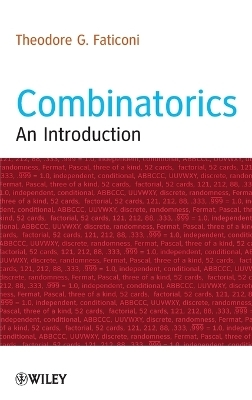
Combinatorics
John Wiley & Sons Inc (Verlag)
978-1-118-40436-2 (ISBN)
- Titel z.Zt. nicht lieferbar
- Versandkostenfrei innerhalb Deutschlands
- Auch auf Rechnung
- Verfügbarkeit in der Filiale vor Ort prüfen
- Artikel merken
Bridges combinatorics and probability and uniquely includes detailed formulas and proofs to promote mathematical thinking
Combinatorics: An Introduction introduces readers to counting combinatorics, offers examples that feature unique approaches and ideas, and presents case-by-case methods for solving problems.
Detailing how combinatorial problems arise in many areas of pure mathematics, most notably in algebra, probability theory, topology, and geometry, this book provides discussion on logic and paradoxes; sets and set notations; power sets and their cardinality; Venn diagrams; the multiplication principal; and permutations, combinations, and problems combining the multiplication principal. Additional features of this enlightening introduction include:
Worked examples, proofs, and exercises in every chapter
Detailed explanations of formulas to promote fundamental understanding
Promotion of mathematical thinking by examining presented ideas and seeing proofs before reaching conclusions
Elementary applications that do not advance beyond the use of Venn diagrams, the inclusion/exclusion formula, the multiplication principal, permutations, and combinations
Combinatorics: An Introduction is an excellent book for discrete and finite mathematics courses at the upper-undergraduate level. This book is also ideal for readers who wish to better understand the various applications of elementary combinatorics.
THEODORE G. FATICONI, PhD, is Professor in the Department of Mathematics at Fordham University. His professional experience includes forty research papers in peer-reviewed journals and forty lectures on his research to colleagues.
Preface xiii
1 Logic 1
1.1 Formal Logic 1
1.2 Basic Logical Strategies 6
1.3 The Direct Argument 10
1.4 More Argument Forms 12
1.5 Proof By Contradiction 15
1.6 Exercises 23
2 Sets 25
2.1 Set Notation 25
2.2 Predicates 26
2.3 Subsets 28
2.4 Union and Intersection 30
2.5 Exercises 32
3 Venn Diagrams 35
3.1 Inclusion/Exclusion Principle 35
3.2 Two Circle Venn Diagrams 37
3.3 Three Square Venn Diagrams 42
3.4 Exercises 50
4 Multiplication Principle 55
4.1 What is the Principle? 55
4.2 Exercises 60
5 Permutations 63
5.1 Some Special Numbers 64
5.2 Permutations Problems 65
5.3 Exercises 68
6 Combinations 69
6.1 Some Special Numbers 69
6.2 Combination Problems 70
6.3 Exercises 74
7 Problems Combining Techniques 77
7.1 Significant Order 77
7.2 Order Not Significant 78
7.3 Exercises 83
8 Arrangement Problems 85
8.1 Examples of Arrangements 86
8.2 Exercises 91
9 At Least, At Most, and Or 93
9.1 Counting With Or 93
9.2 At Least, At Most 98
9.3 Exercises 102
10 Complement Counting 103
10.1 The Complement Formula 103
10.2 A New View of ?At Least? 105
10.3 Exercises 109
11 Advanced Permutations 111
11.1 Venn Diagrams and Permutations 111
11.2 Exercises 120
12 Advanced Combinations 125
12.1 Venn Diagrams and Combinations 125
12.2 Exercises 131
13 Poker and Counting 133
13.1 Warm Up Problems 133
13.2 Poker Hands 135
13.3 Jacks or Better 141
13.4 Exercises 143
14 Advanced Counting 145
14.1 Indistinguishable Objects 145
14.2 Circular Permutations 148
14.3 Bracelets 151
14.4 Exercises 155
15 Algebra and Counting 157
15.1 The Binomial Theorem 157
15.2 Identities 160
15.3 Exercises 165
16 Derangements 167
16.1 Fixed Point Theorems 168
16.2 His Own Coat 173
16.3 Exercises 174
17 Probability Vocabulary 175
17.1 Vocabulary 175
18 Equally Likely Outcomes 181
18.1 Exercises 188
19 Probability Trees 189
19.1 Tree Diagrams 189
19.2 Exercises 198
20 Independent Events 199
20.1 Independence 199
20.2 Logical Consequences of Influence 202
20.3 Exercises 206
21 Sequences and Probability 209
21.1 Sequences of Events 209
21.2 Exercises 215
22 Conditional Probability 217
22.1 What Does Conditional Mean? 217
22.2 Exercises 223
23 Bayes? Theorem 225
23.1 The Theorem 225
23.2 Exercises 230
24 Statistics 231
24.1 Introduction 231
24.2 Probability is not Statistics 231
24.3 Conversational Probability 232
24.4 Conditional Statistics 239
24.5 The Mean 241
24.6 Median 242
24.7 Randomness 244
25 Linear Programming 249
25.1 Continuous Variables 249
25.2 Discrete Variables 254
25.3 Incorrectly Applied Rules 258
26 Subjective Truth 261
Bibliography 267
Index 269
| Erscheint lt. Verlag | 12.3.2013 |
|---|---|
| Verlagsort | New York |
| Sprache | englisch |
| Maße | 165 x 241 mm |
| Gewicht | 599 g |
| Themenwelt | Mathematik / Informatik ► Informatik ► Theorie / Studium |
| Mathematik / Informatik ► Mathematik ► Graphentheorie | |
| ISBN-10 | 1-118-40436-X / 111840436X |
| ISBN-13 | 978-1-118-40436-2 / 9781118404362 |
| Zustand | Neuware |
| Haben Sie eine Frage zum Produkt? |
aus dem Bereich


